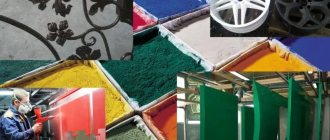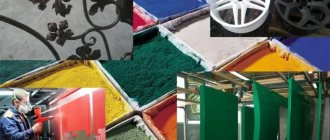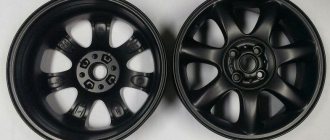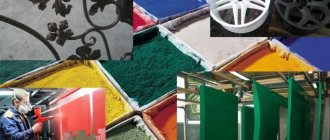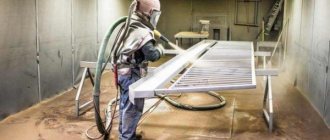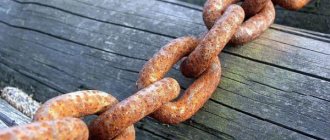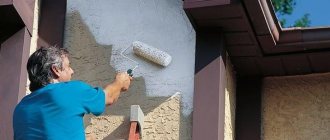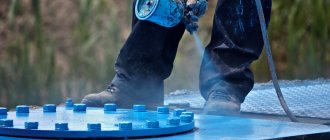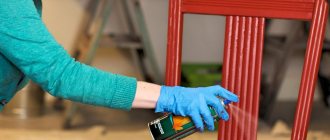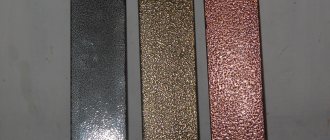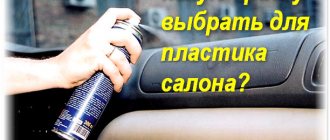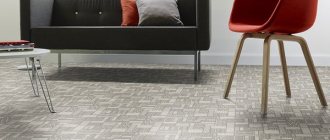Metal entrance doors are currently installed almost everywhere, since, in fact, they do not have worthy alternative options. At the same time, the most popular and widely used finishing option for such products, without a doubt, is powder coating. The reasons for this situation are obvious - the combination of strength, durability and reasonable price of this type of finish. However, even the most durable finishes may require repairs, resulting in the need to repaint a powder coated metal door.
Types of powder paints
Powder paint is a material with colored pigment in powder form. It protects the metal surface from moisture and prevents rust. Durability, additional strength and even electrical insulation are its features.
In addition to the pigment, the composition also includes other substances: resins form a film, and catalysts are responsible for hardening. Powder coating is common in construction, automotive and interior design. This way you can achieve a matte or glossy, voluminous or flat surface.
Paint is divided into 2 types:
- Thermoplastic. The decisive factor here is high temperature. Resins are added to the composition: vinyls, nylons or polyester. After heating, they form a hard coating preserving the composition and structure of the original raw material. This powder coating allows the metal object to be reheated and the layers re-formed.
- Thermosetting. Film formation occurs as a result of a chemical reaction. Acrylic, epoxy or polyester resins are used to produce paints.
You can paint objects of any size and even with a complex design Source rzsd62.ru
Thermoactive colors are suitable for products that are used in harsh climatic conditions. Once applied, the powder coating reforms and does not deform when reheated.
The components in the composition are safe. They have a high degree of flowability, which is why they do not stick to objects and skin. The shelf life is unlimited, the color does not fade, and the consistency does not thicken over time. Properties are preserved until the moment of use. No solvent needed.
See also: Catalog of companies that specialize in paints and varnishes and related work
Preparing the surface for painting
The logical conclusion from the above is the need to perform high-quality and thorough preparation of the metal surface before painting the front door with powder coating. First you need to dismantle the sash, and then all the removable fittings. This will protect them from any damage during work.
Then you should clean the surface of the canvas from the old coating. As already noted, this is not at all easy to do, given the strength of the powder-polymer protective layer, as well as its resistance to various influences, including climatic, mechanical and even chemical. Therefore, a set of measures is usually used for cleaning, in particular:
- treatment with strong solvents;
- use of mechanical abrasive tools;
- cleaning the metal surface with special brushes and scrapers.
The choice of a specific method for performing preparatory work depends on the condition of the powder coating, as well as the material used to create it. The best option is sandblasting the surface, however, it also cannot be done at home. Another commonly used option is to use a regular angle grinder, such as an angle grinder, with special attachments. After mechanical cleaning of the surface, it should be prepared for painting. To do this, degreasing is performed using conventional solvents - white spirit or acetone.
Dyeing technology
When powder painting, painting technology is of great importance. The idea is to spray dry particles onto a degreased and cleaned surface. Positively charged paint particles easily stick to a negatively charged metal surface. This creates an even and uniform layer.
Only two spraying methods are used:
- Electrostatic . Electrostatically charged powder is applied to the grounded surface. This is done using a powder coating gun. Kohler acquires an electrical charge due to ionized air. It is located in the corona discharge area and is formed between the electrodes of the charging tip and the surface to be painted.
Electrostatic Painting Source graco.com
A high voltage source is built into the sprayer design. The main disadvantage of this method is the inability to apply paint into small depressions and recesses.
- Tribostatic . This method uses compressed air. As a result of friction with the dielectric, a charge appears. It holds paint molecules on the surface being painted. The dielectric is fluoroplastic - the atomizer is made from this material. This method is used for painting products with complex geometry. It is possible to use multi-jet nozzles, which increase the accuracy and uniformity of paint application.
How does powder coating work?
Powder paint is sprayed onto the cleaned product
.
During the spraying process, powder
paint particles are electrically charged from an external source or by electrification during friction.
powder
particles to the object being painted, which has an opposite charge.
Interesting materials:
How to feed fruit trees in the fall? How to feed a money tree to make it bloom? How to feed the money tree Crassula? How to feed trees for fast growth? How to feed trees at the end of August? How to feed fruit trees in August? How to feed fruit trees in June? How to coat wood before painting with varnish? How to cover a wooden kitchen table? How to cover a cut tree?
Stages of work
Powder coating technology consists of three stages of work: surface preparation, painting and polymerization.
Surface preparation
It includes: cleaning from contaminants, degreasing, phosphating.
Dirt, rust and oxides are removed from the surface of a metal product. If you skip the cleaning step, the paint will peel off and you will have to redo it. The best cleaning method is shot blasting. Small granules are directed to the surface under pressure or using centrifugal force. Cast iron or steel granules, as well as sand, are used as granules.
Hammer painting of the entrance structure
The number of different finishing options for entrance metal structures is constantly increasing. Today, hammer painting of doors is rapidly gaining popularity, which has not yet reached the level of powder-polymer, but is confidently approaching it. The reasons for this are obvious - there are a number of advantages of this type of design, in particular:
- Excellent performance characteristics, including resistance to temperature, mechanical and other similar influences;
- High level of rust resistance, which allows the material to be applied without preliminary anti-corrosion treatment;
- The ability to perform finishing at home, which makes hammer painting stand out compared to powder painting;
- Simplicity of technology, allowing the material to be applied with a spray gun, roller or brush, combined with quick drying;
- The presence of dirt-repellent qualities that simplify the care of the coating;
- A variety of textures and colors, as well as an original and aesthetically pleasing texture of the decorative layer.
If the metal surface is properly prepared, hammer paint can be applied directly after degreasing. It is recommended to first prime the locations of the welds, and then the entire area to be treated. After this, the workman needs to follow the instructions for use of the material, which usually involves first diluting it to the desired consistency and then applying it with a sprayer or roller. In most cases, painting does not take much time, since the drying time of individual layers is extremely short.
Video description
This video shows how to clean rust from metal.
Chemical cleaning or etching is suitable for degreasing the surface before powder coating of metal products. Sulfuric, nitric or phosphoric acids are used as a reagent. Phosphating is similar to priming. When treated with a special composition, a phosphate film is formed, which improves adhesion.
Coloring
For these purposes, a special room is equipped - a chamber - with a forced air suction system. Large-sized products are painted in walk-through type chambers, and small parts are painted in dead-end type chambers. A special gun sprays the color. The step-by-step process looks like this:
- Powder paint is poured into a special hopper and mixed there with air. The proportions are adjusted using valves.
- A mixture of paint and air passes through a spray gun with a high-voltage source, acquiring a positive charge.
- The process of spraying paint onto the product occurs.
- The last step is extraction to remove loose particles. Entering a special bunker, they are again sent through the painting cycle.
Correction of defective polymer powder coatings
In any production process, including when painting with powder materials, coatings can be obtained that do not meet existing quality standards (powder coating defects). The result of this is the exclusion of parts from use and sale; they are called defective. If the coating is rejected, the part can be sent back into the production process to have the coating corrected.
Powder coatings can be corrected, for example by re-coating, which can reduce scrap rates.
Regulations for the acceptance of finished coatings must be clearly formulated, documented and communicated to all interested personnel, including the customer. Coatings that have already passed acceptance can serve as a standard for comparison. Carrying out systematic testing of products and training of key personnel are important measures to reduce defects.
Before correcting defective coatings, it is necessary to resolve the main question of whether it is advisable or not from an economic point of view. In this case, you should take into account:
- material costs and labor costs to correct defective coatings;
- costs of storing parts with defects in a warehouse;
- costs for removing defective coatings, including costs for preparation and transportation of parts.
By identifying and comparing these costs, you can choose the option that involves the lowest costs. The importance of a thorough cost analysis for each possible alternative with rejected coatings cannot be underestimated.
Ways to eliminate defects
There are various ways to correct coating defects. The most commonly used are recoating, touch-up spray paint, and recuring.
Recoating
One of the advantages of coatings obtained from powder paints is the ability to renew them by reapplying the same paints. Typically, a second coating can be applied over the first without adversely affecting the appearance or physical properties of the coating.
A recoating is a repetition of the first. However, sometimes it may be necessary to adjust the parameters of its application in order to successfully correct existing defects.
Whenever a part is recoated, the entire surface must be coated to an adequate thickness. Attempting to recoat only part of a part is a big mistake, as it will prevent you from obtaining a uniform coating thickness.
Repeated coatings generally provide good adhesion between layers. Some adhesion problems can occur with epoxy paints, especially if they have been over-cured. On the other hand, polyester and epoxy-polyester paints generally adhere well when reapplied.
Before recoating large numbers of parts, it is recommended to test adhesion between coats. This check is especially necessary if the first coating is recured.
It is important to properly ground the part when recoating. Good grounding is necessary to ensure electrostatic attraction of the powder paint to the part being painted.
Excessive heating of a coated product due to the need to cure a recoat can cause pyrolysis of the first coating, which can also affect adhesion between layers. For coatings that have been over-cured, light sanding of the surface is required to obtain satisfactory intercoat adhesion.
Grinding
If there are defects in the original coating - stains, bubbles or small bulges from contamination - these areas must be sanded before recoating. If the initial coating is left uneven, these unevenness will likely appear after the second coating is applied.
It is important to choose the correct sandpaper grit. Coarse sandpaper will remove the defect faster, but will leave marks that may be visible after applying a second coat. For final sanding, use fine-grit sandpaper to achieve a smooth surface. Depending on the complexity of the defect and the shape of the part, grinding can be done manually or using special equipment. It can be electric or pneumatic. One of the most common machines is the belt sander.
The grinding operation should be carried out in a ventilated area with a dust collection system to minimize contamination of the equipment. Operators should be equipped with safety glasses, dust masks and other safety equipment.
Tinting with liquid paints
It may always be necessary or desirable to use liquid paint for touch-ups. This may include marking, touching up unpainted areas of the surface, as well as areas with damaged coatings that occurred during unloading/loading or final assembly.
The places where parts are hung, if they are clearly visible, are recommended to be touched up manually with a small brush. Applying paint by spray on the surface of a part with significant defects is acceptable where the spray lines will be less noticeable.
The choice of materials for tinting is influenced by the following factors:
- type of paint hardener;
- operating conditions of the coating, such as resistance to the external environment and chemicals;
- drying time;
- the amount of touch-up work required.
Two-pack liquid paints typically provide optimal adhesion and film properties when applied to defective coatings. The disadvantage, however, is that this application requires additional mixing time and higher costs.
The most commonly used material for touch-up coatings is air-drying thermoplastic polyacrylate paints. This material is economical and provides good adhesion to most powder paint coatings. It is relatively easy to apply and dries quickly. When smaller volumes of tinting materials are required, polyacrylate compounds packaged in aerosol cans are convenient.
It is necessary to pay attention to the use of a combination of powder and liquid paint for tinting. It is recommended to conduct an adhesion test before using any powder-liquid paint combination. The adhesion characteristics of liquid touch-up paints may vary due to different solvents as well as the resins used. Sometimes the appearance of the coating can be improved by selecting a solvent, as well as by sanding the surface before applying liquid paint.
It is also important to consider the drying time required for the tinted layer to dry. Parts that have been touched up with liquid paint must be allowed to sit for a sufficient period of time before they are packaged and shipped.
When working with liquid paints for touch-up, you must follow all the precautions recommended for working with solvent-soluble liquid paints. These precautions also include removing any solvents used from the painting area.
Post-curing of coatings
If a coating is rejected due to insufficient cure, it can easily be corrected by returning it to the oven and going through the required cure cycle. However, it is necessary to control the thermal re-curing process.
Parts that are not properly coated are susceptible to damage, so additional precautions must be taken to protect these parts during storage and handling.
Methods for eliminating defective coatings
Removal of coatings can be accomplished through the use of chemicals, mechanical means and firing.
Chemical cleaning may be used if the coating must be completely removed. This process is used when the substrate cannot withstand high temperatures or mechanical methods.
Chemical cleaning is used for coatings that have the following defects:
- poor adhesion;
- surface defects that require too much grinding;
- impossibility of fitting the part due to the coating being too thick.
The defective part is immersed in a hot or cold chemical bath. Depending on the substrate and coating material, various chemical media can be used: acids, alkalis, solvents such as methylene chloride or toluene. After removing the coating, it may be necessary to neutralize the part before washing, then apply a corrosion inhibitor to prevent oxidation of the clean surface.
Chemical coating removal processes must comply with environmental regulations. Harm caused to the health of personnel during work (exposure to chemicals and vapors) must be taken into account when choosing chemicals.
Methods for mechanical removal of coatings include abrasive sandblasting and plastic bead blasting. Both cleaning processes are capable of returning the substrate to its original condition, allowing the standard pre-surface preparation and powder coating process to be repeated.
Abrasive sandblasting is essential when the cured coating must be completely removed and the substrate can withstand the abrasive action. Solid abrasive particles, such as steel balls, sand, glass beads or aluminum oxide, are applied to the surface being treated to remove the coating. Different types of equipment can be used depending on the part that needs to be cleaned.
During the cleaning process with plastic granules, you can remove part of the coating surface or completely clean the entire surface. This process can be used on any type of substrate, including aluminum and brass, without causing harm. To remove the coating, lightweight plastic granules are fed at high speed onto the surface of the coating. Depending on the type of coating, different plastic granules can be used.
Thermal cleaning is carried out in pyrolysis ovens. This process can only be used on substrates that can withstand high temperatures (approximately 500 °C). Since some types of coatings are not suitable for firing, trials must be made before the process is accepted for widespread use.
The part to be fired is placed in a container, which is then loaded into a specially designed oven. Depending on the mass of the metal and the furnace system, the parts are kept for 4 to 8 hours at a temperature of approximately 450 °C. Parts must be heated and cooled slowly to prevent thermal distortion. The solid residue of combustion products is removed by immersing the part in a special solution or by washing with water. A corrosion inhibitor must then be applied to prevent oxidation of the clean surface.
The design of the firing furnace is determined by the specifics of the parts and material. This equipment must be registered and approved for use in accordance with airspace protection and air emissions control legislation.
It is important that the surface to be painted is clean. If the surface is not clean, it can negatively affect both the appearance of the coating and its adhesion. If dust and contaminants are present, multiple flushes must be used. Parts to be remanufactured that have had their coating completely removed must go through the standard pre-conditioning process.
EQUIPMENT FOR APPLYING POWDER PAINTS IN BELARUS, POWDER PAINT. FOR ANY QUESTIONS CONTACT US, WE CAN HELP YOU!
+375296151445
+375172026595
Video description
This video shows the consequences of underbaking and overbaking paint.
The process of paint polymerization occurs. It takes 15-30 minutes to complete the full cycle. Microparticles of powder paint are melted, forming a film, then hardened and cooled. The time for this stage depends on the size of the part, the type of oven and the type of paint.
The temperature required for the process is kept in the range of 150-200 °C. After which the molten powder fills all small irregularities, this guarantees tight contact between the paint and the surface.
Then the part is cooled. The coating becomes durable, and the product receives protection from adverse environmental influences.
Video description
This video shows the powder coating process
- To spray powder materials, use the minimum required amount of air. When oversaturation occurs, there is an increase in color consumption, increased load on the equipment, disruption of the electrification process, changes in the granules of the powder material, plus, visibility in the spray booth noticeably deteriorates.
- Use air of the best quality, without impurities.
- Carefully homogenize the powder mixture before use.
- Do not mix different colors. Before using a new color, thoroughly clean the equipment.
- Pay great attention to surface preparation before painting.
- Storage conditions for powder paints must be observed to avoid deterioration of the raw materials, which will affect the final result.
- The technological process must be followed in detail at all stages of painting work.
- Monitoring, prevention and maintenance of units is a necessity.
- Correctly configured production cycles guarantee a reduction in the loss of coloring pigment to 2% -5%.
Rules and recommendations will help achieve uniformity and elasticity of the coating, as well as a long service life.
Restoration of powder coating
Many owners of entrance structures are wondering whether it is possible to paint metal doors with powder paint over the old coating? Obviously, such work cannot be organized at home. However, with minor damage to the decorative layer, it is quite possible to restore it using your own resources.
To do this, it is necessary to treat the location of the defect with a solvent, and then cover it with a special spray. This type of material, designed to work specifically on polymer powder coating, is available today on the domestic market. If necessary, you can contact specialized companies that sell steel doors and carry out maintenance and warranty work. They will have no problem providing powder coating repair services using the specified material, and at very reasonable rates.
Briefly about the main thing
Powder paint is a modern type of painting materials for metal. The scope of application ranges from painting small household appliances and interior items to metal structures.
There are two main types of powder paints - thermoplastic and thermosetting. The choice of method depends on the tasks at hand. There are also only two types of dyeing technologies - electrostatic and tribostatic. In the first case, a powerful high voltage source is used, in the second it is absent.
Painting is done in 3 stages: first, prepare the surface - clean it of dirt, dust and old layers of paint. Products are painted using an air suction system. The final stage is polymerization. The painted object is sent to the oven to fix the paint, followed by the processes of hardening and cooling.
Ratings 0
